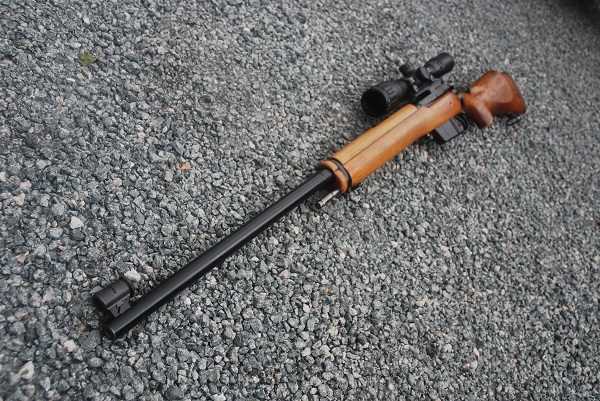
This has me a little confused.
'#4 Mk2, UF '55' is a Fazackerly made Lee Enfield #4 Mk II rifle from 1955, I have a similar rifle from the same UF '55 lot, but with an A 189xx serial number, very close but no cigar, but not an envoy or enforcer, it is chambered in .303 British, the classic Lee-Enfield load. There were versions of the Enfield as dedicated marksmanship rifles, the L39 & L41 but I'm not familiar with the markings these would have had on them, I'm assuming it would have been marked as L39, or L42 respectively, not #4 Mk II???
However the ammunition headstamp is for a 7.62mm NATO load (the L42A1), not to be confused with the L42A1 designation of the Envoy. The crosshair (cross in a circle) denotes NATO spec ammunition BTW. There may also be a green, or black spot (filled in circle) on the box.
Could you have a #4 Mk II rebarreled to 7.62mm? This was a popular conversion 'back in the day' & was used a lot for long range (1,000 Yd) competition.
Is there a caliber marking on the barrel itself? this should clarify the chambering of your exact rifle & remove confusion. The 7.62mm barrels were a lot thicker than the original .303 barrels, but this was done to handle the higher pressure of the 7.62mm load, not for anything else.
As a hint. The Lee Enfields had wood almost all the way to the muzzle, only about the last 2' of barrel being visible, they also had a wooden covering over the top of the barrel to the same point in the length. The Envoy & Enforcer rifles had a much shorter front stock which stopped about 1/2 way along the barrel length & the top of the barrel was exposed all the way to the breech. Of course this may have been changed as part of a conversion to 7.62mm.
This is my Lee Enfield #4 Mk II.
The sight, mount & cheekpiece have been added to a stock rifle by me, but you get the idea of what a #4 Mk II looks like in .303 Brit.
'#4 Mk2, UF '55' is a Fazackerly made Lee Enfield #4 Mk II rifle from 1955, I have a similar rifle from the same UF '55 lot, but with an A 189xx serial number, very close but no cigar, but not an envoy or enforcer, it is chambered in .303 British, the classic Lee-Enfield load. There were versions of the Enfield as dedicated marksmanship rifles, the L39 & L41 but I'm not familiar with the markings these would have had on them, I'm assuming it would have been marked as L39, or L42 respectively, not #4 Mk II???
However the ammunition headstamp is for a 7.62mm NATO load (the L42A1), not to be confused with the L42A1 designation of the Envoy. The crosshair (cross in a circle) denotes NATO spec ammunition BTW. There may also be a green, or black spot (filled in circle) on the box.
Could you have a #4 Mk II rebarreled to 7.62mm? This was a popular conversion 'back in the day' & was used a lot for long range (1,000 Yd) competition.
Is there a caliber marking on the barrel itself? this should clarify the chambering of your exact rifle & remove confusion. The 7.62mm barrels were a lot thicker than the original .303 barrels, but this was done to handle the higher pressure of the 7.62mm load, not for anything else.
As a hint. The Lee Enfields had wood almost all the way to the muzzle, only about the last 2' of barrel being visible, they also had a wooden covering over the top of the barrel to the same point in the length. The Envoy & Enforcer rifles had a much shorter front stock which stopped about 1/2 way along the barrel length & the top of the barrel was exposed all the way to the breech. Of course this may have been changed as part of a conversion to 7.62mm.
This is my Lee Enfield #4 Mk II.
The sight, mount & cheekpiece have been added to a stock rifle by me, but you get the idea of what a #4 Mk II looks like in .303 Brit.
.jpg_thumbnail0.jpg)

Enfield Serial Number Look Up
New Enfield Enforcer. Enforcer 134 and a couple of other Enfields 'for fun'. I have heard some comments about certain ranges of scope serial numbers being used. This is a Genuine Police Issued Enfield Enforcer serial number 089; it is matching on the action, bolt & magazine. It is fitted with a correct Parker Hale 5A target sight base that required the modified safety. Sadly on the the base of the PH sight is fitted, the top arm has been lost due to the passage of time.